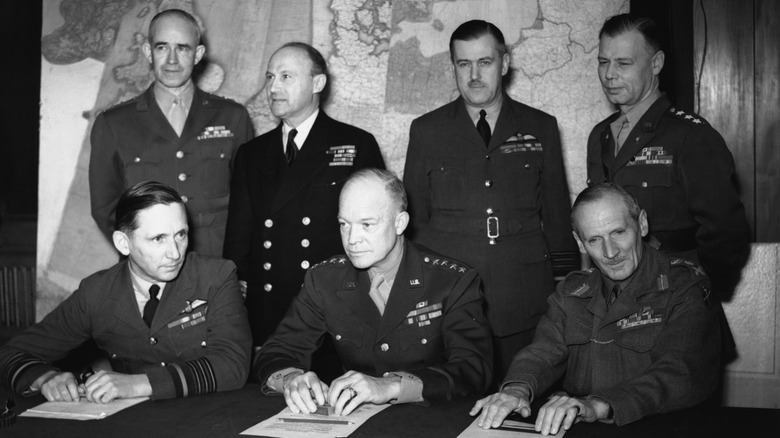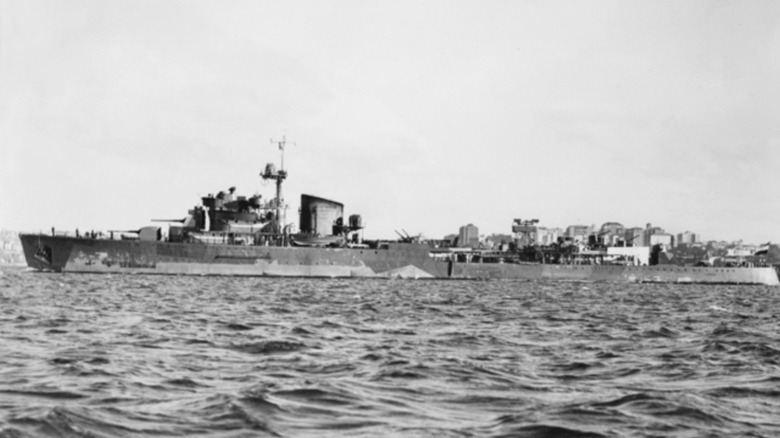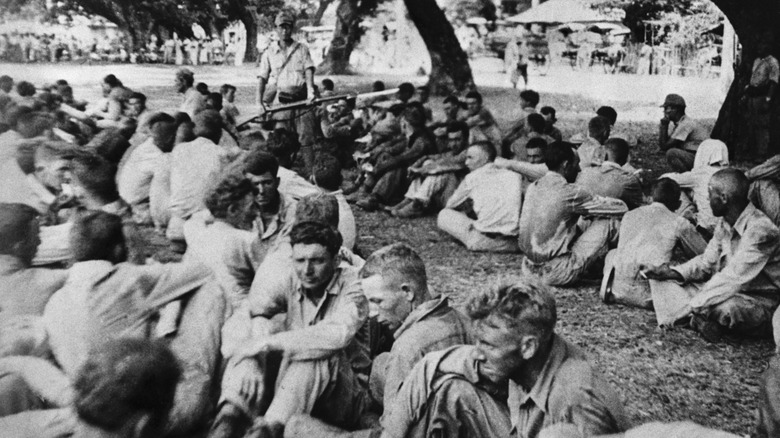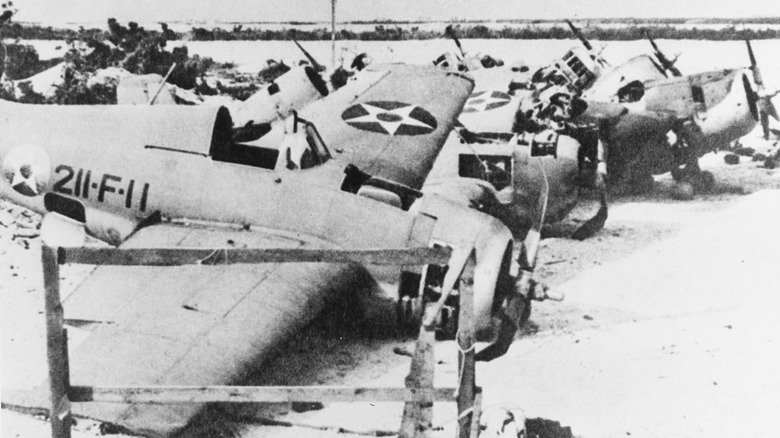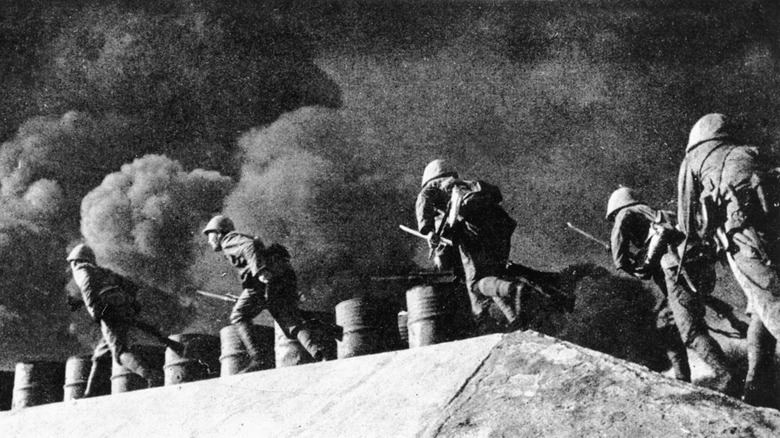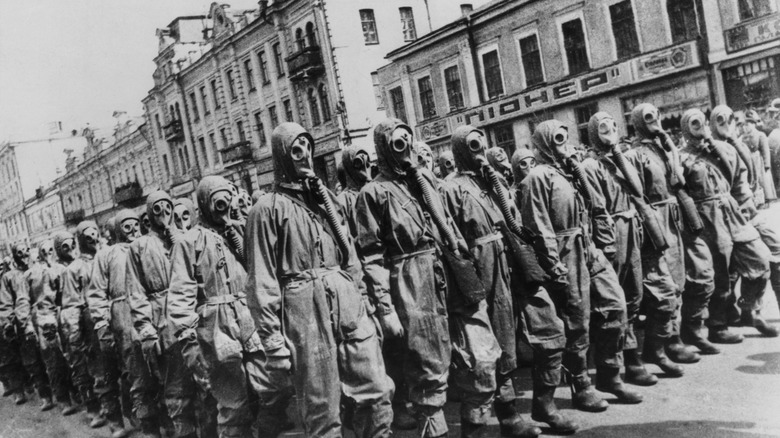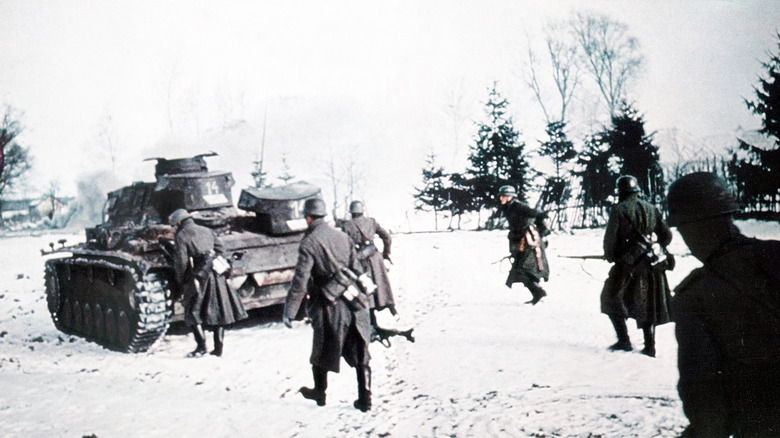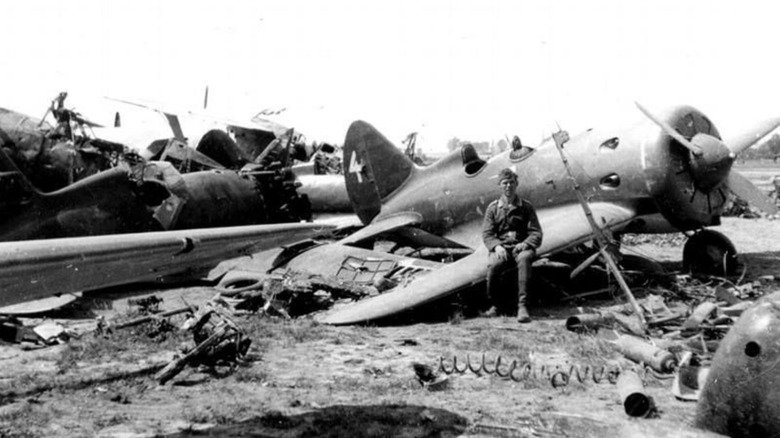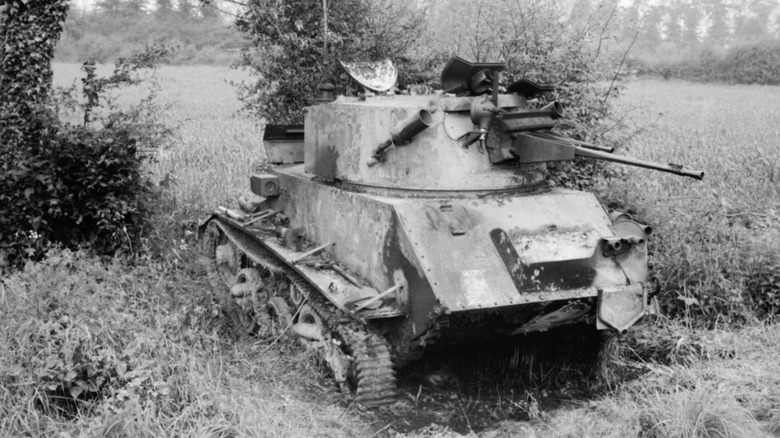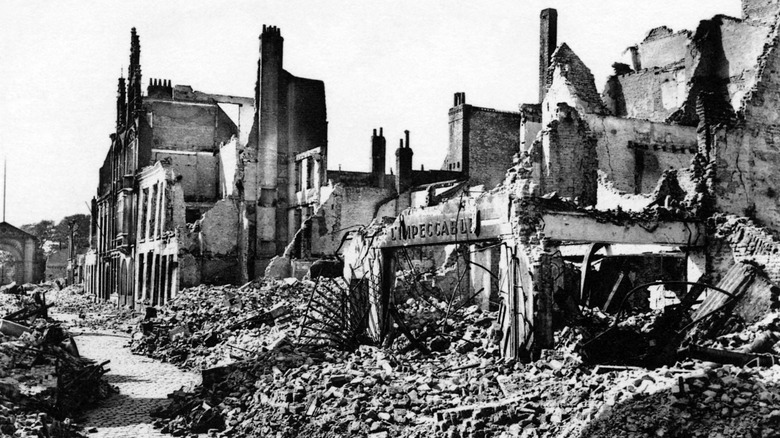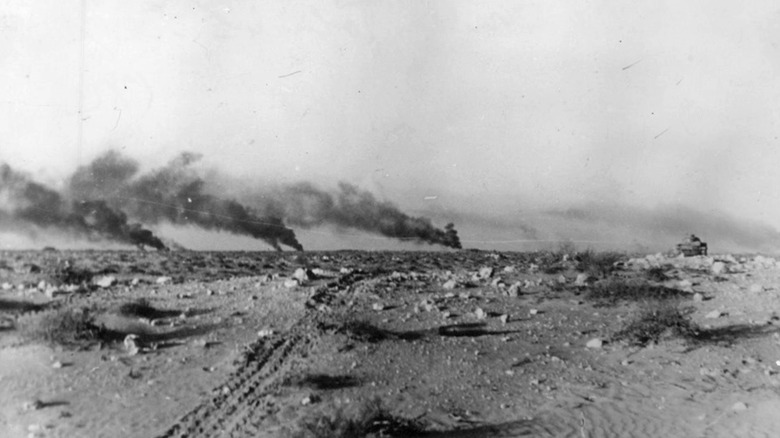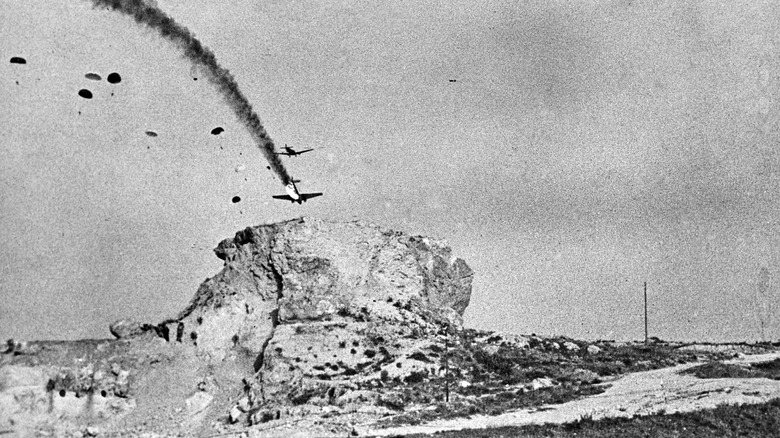11 Battles That The Allies Actually Lost During WWII
Many of the most important battles of World War II are those that resulted in Allied victories. After all, the Allies would go on to win the war, so the biggest, most significant battles tend to be remembered as the ones they won as well. But during the early years of the war, especially, Allied victories were hard to come by. The Germans overran Europe at such a rapid pace that it seemed no army could stop them. This meant the Allies suffered loss after loss.
These terrible defeats resulted in some of the most nightmarish battle stories of World War II. Troops who surrendered became prisoners of war, sometimes for years, and endured untold hardships. Other times, the defeated soldiers were murdered or tortured. But even defeats had bright spots, with the intense pressure only found in the midst of a losing battle leading to some seemingly superhuman acts of heroism.
While the Allies lost dozens of battles, these ones are all notable for different reasons, from the grit of the fighters to tactics and results that changed warfare. Here are 11 battles that the Allies actually lost during WWII.
Battle of Badung Strait
The Battle of Badung Strait took place the night of February 19-20, 1942. The day before, on February 18, the Japanese invaded Bali. They had not faced much opposition from the Allied forces in the Pacific since their sneak attack on Pearl Harbor in December 1941, and were steadily working their way, conquest by conquest, to Indonesia (then owned by the Netherlands), which had oil that would come in very handy during the war. Bali was only a small pitstop on the way to that goal, but it did have an airfield that the Japanese believed would help their operations enough to make an invasion worth it.
The American-British-Dutch-Australia (ABDA) Command was too late to stop the invasion, but they tried to do some damage. The Battle of Badung Strait took place between six Japanese ships that were trying to get to Bali as reinforcements, and 10 Allied ships, not including their submarines and planes. The Allies also got lucky, as in the darkness, two of the Japanese ships got confused and began firing on each other.
Despite this friendly fire mistake, plus being enormously outgunned in the naval battle, Japan destroyed and damaged multiple Allied ships. It was the first proof that the Japanese navy had superiority over the Allies in certain areas, specifically fighting at night. The Japanese suffered casualties, and the ships were forced to turn around without making it to Bali, but the battle was considered a decisive victory for Japan.
Battle of Bataan
During World War II, the Philippines was still a colony of the United States. Even before the Japanese attacked Pearl Harbor, the Philippines was seen as an important barrier against Japan's imperial ambitions in Southeast Asia. But a series of military losses meant that by January 1942, the Japanese controlled all but one small section of the country. The Battle of Bataan would be the last stand for the Allies who were trying to keep Japan from taking all of the Philippines.
When the U.S. and Filipino troops on Bataan began fending off the Japanese attack on January 6, 1942, they thought they only needed to hold out until reinforcements arrived. But there was no backup coming. Despite this, they fought on for three months with outdated weapons and a shortage of ammo. Dwindling supplies meant troops were only given half rations. By April, it was clear the troops were no longer fit to fight, and the U.S. was forced to surrender.
The Battle of Bataan is perhaps more famous for what happened after the Allies surrendered. Between 60,000 and 80,000 Filipino and American prisoners of war, already weakened from their three months with not enough food, were forcibly marched 65 miles through the jungle to POW camps. The things that really happened during the Bataan Death March are horrible to contemplate. The POWs were forced to go without food and water and received no medical care. This resulted in 10,000 of them dying on the torturous journey.
Battle of Wake Island
The attack on Pearl Harbor is the most famous clash to occur in December 1941, but it was not the only one. Japan had bigger plans than just the attack in Hawaii, and invaded multiple locations around the Pacific in quick succession. One of these attempts resulted in the Battle of Wake Island. (Confusingly, Wake Island is actually an atoll made up of three islands.)
A few hours after Pearl Harbor (although on December 8, due to the locations being on different sides of the International Date Line), the Japanese attacked Wake Island, located about 2,000 miles further west in the Pacific. The military outpost was still under construction, and only 524 Marines and other military members were there to defend it, far outnumbered by the civilian contractors on the island. Completely outgunned and outmanned by the attacking Japanese forces, Wake Island should have fallen immediately. Instead, despite incessant bombing, the U.S. troops somehow held out for weeks, assisted by civilian volunteers, only surrendering on December 23. Even then, some of the Marines, many of whom were wounded, wanted to keep fighting and had to be convinced that the decision to give up wasn't a hoax.
The Japanese had many ships and aircraft damaged or destroyed during the two-week fight, but in the end, the battle counted as a victory for them. They held on to Wake Island until the very end of World War II.
Battle of Hong Kong
The United States was not the only Allied nation that had colonized islands in the Pacific. As war with the Japanese became more likely, the British wanted reinforcements to protect their colonies, which resulted in Canadian troops being sent to Hong Kong to join the British, Indian, and local troops already there. War came with the attack on Pearl Harbor on December 7, 1941, and the Japanese attacked Hong Kong just six hours later.
Unprepared for battle (especially the Canadians, who had yet to fight in World War II), saddled with outdated equipment, and outmanned at 35,000 Japanese forces compared to 13,500 Allied troops, it was only a few hours before the Allied forces began to retreat. Despite this, and running out of food and water, the governor of Hong Kong refused Japanese demands to surrender.
The Allied troops held on until Christmas Day, with many notable acts of heroism, but there were concerns that continuing to fight would put the civilian population in too much danger. So in the end, Japan succeeded in its invasion. One group of men was so determined to fight to the end that their superiors had to order them in writing to surrender. Allied troops who had been too badly wounded were murdered by the enemy rather than taken captive as prisoners of war. Hundreds of Allied troops had already died in the fighting. Japan kept control of Hong Kong for almost four years.
Battle of Kiev (1941)
Having learned nothing from Napoleon Bonaparte's mistake over a century before, Adolf Hitler decided to invade the Soviet Union in 1941. The two countries had signed an agreement not to attack each other two years before, but this ended up being worth no more than the piece of paper it was written on. On June 22, Operation Barbarossa began. One of the most important cities to conquer for the Germans was Kiev — now the capital of Ukraine, but then controlled by the USSR. Ukraine had two vital resources: wheat and coal. If Hitler wanted to win the war, he needed larger supplies of both.
The 1941 Battle of Kiev began on July 7 ... and stretched on and on. The Germans started to get desperate. They planned an unorthodox maneuver to surround the city, which resulted in the largest number of troops ever encircled by an enemy army in known military history. The last troops defending the city surrendered on September 26. The Soviet losses were the worst any force in World War II had suffered up until that time. Hundreds of thousands of soldiers were taken prisoner.
Adolf Hitler would go on to call it "the biggest battle in the history of the world" (via "Kiev 1941: Hitler's Battle for Supremacy in the East"). It would also result in one of the biggest massacres. Between September 29 and 30, German troops shot and killed 33,771 Jewish residents of Kiev at a nearby ravine called Babyn Yar.
Battle of Brody (1941)
Hitler had big plans for Russia if he won World War II. After all, he had promised the German people that they would have more Lebensraum ("living space"), which meant adding to the territory controlled by the Nazis. Hitler considered the USSR to have some of the best land and wanted it for the Germans. A successful invasion was vital to all his plans.
Tanks were a key part of the German invasion of the USSR. On July 12, 1943, the two sides fought to what was essentially a draw in the Battle of Prokhorovka, which historians thought for decades was the largest tank battle in the history of warfare. But more recent research has uncovered that a much less famous battle, one that had a definite winner and loser, was much, much bigger.
The Battle of Brody took place between June 23 and 30, 1941 (not to be confused with the 1944 battle of the same name). While largely forgotten, this week-long clash between the Germans and the Soviets was probably the largest tank battle ever fought, and one that set the stage for the many tank battles that would come after it on the Eastern Front. It saw 5,000 Soviet tanks vs. 1,000 German tanks, although the Soviets saw more than half of theirs destroyed during the chaotic battle. As the Soviet losses mounted, small groups were surrounded and forced to fight to the death, while fleeing soldiers left panic in their wake.
German-Soviet Air War 22 June 1941
The German-Soviet Air War of June 22, 1941, was technically a battle, but its outsized effect on World War II makes it worthy of its rather grander name. It occurred on the first day of Operation Barbarossa, the German invasion of the Soviet Union. At the beginning of the day, the USSR had an air force; by the end of the day, effectively, they did not.
In between was the largest one-day air battle in history. The Germans attacked with no warning, allowing the Luftwaffe to have the upper hand from the beginning. Using just 2,255 planes, the Germans managed to shoot down or destroy 1,811 Soviet planes, while losing only 78 planes themselves. According to historians, this ratio makes the Luftwaffe's victory, from a numerical standpoint, the greatest air force victory in history. But it was hardly a fair fight. Most of the Soviet planes never managed to get airborne before being destroyed, and those that did were piloted by novices.
It was a wake-up call to the Allies that the Germans had the upper hand when it came to an air force. Perhaps more importantly, such a decisive victory and the near-total destruction of the Soviet air force almost certainly allowed for easier German victories over the subsequent weeks and months of Operation Barbarossa.
Battle of Abbeville
The timeline of the European Front in World War II really begins with the Battle of France. Starting on May 10, 1940, the German military Blitzkrieged its way through the Low Countries and into France. Once the invading force crossed the Somme, it was feared they would make it even further, to the English Channel. This could not be allowed to happen.
The Battle of Abbeville was the Allied attempt to stop the advance of the Germans that took place between May 27 and June 4, 1940. Firsthand accounts relay that the Allied soldiers didn't have enough maps or tanks, and that the Germans mowed the Allied troops down with machine guns hidden in rye fields, while their tanks fell victim to mine fields and anti-tank guns.
The failure of the Allies at Abbeville was devastating because it allowed the German army to reach the English Channel. From a logistical standpoint, this was bad because the flow of both supplies and information from British troops in the north and French troops in the south was disrupted. But the psychological effect was even worse: By reaching the English Channel, the Germans could "see" England. An invasion now seemed not only likely but inevitable. Winston Churchill was worried enough to prepare plans for guns and barbed wire to protect government buildings in London.
Battle of Dunkirk
The Battle of Dunkirk may be the most famous and infamous Allied loss in World War II, although its successful evacuation of Allied troops from the coast of France before they could be crushed by the German forces is often seen as a win in its own right.
As Adolf Hitler's troops tore across Western Europe in the spring of 1941, the Allied troops were forced to continuously retreat, until it became clear that they were fleeing for their lives. Some units dug in and fought to the death to allow other troops to make it to the coast of France at Dunkirk.
But Hitler made a critical mistake in the Battle of Dunkirk: He delayed the final killer blow, ordering his tanks to wait a few days before moving in, giving the Allies time to evacuate their forces to England. While the battle itself was a total tactical defeat that resulted in Allied forces leaving the European continent for years, not returning until the successful landing at Normandy on D-Day in 1944, the fact that so many soldiers were saved under such difficult circumstances was nevertheless a victory of sorts and even boosted British morale. It also inspired Winston Churchill's declaration that "we shall fight on the beaches, we shall fight on the landing grounds, we shall never surrender."
Operation Battleaxe
Adolf Hitler had not planned on fighting part of the war in North Africa, but when British forces pushed the Italians out of eastern Libya, the Germans sent them reinforcements in the form of General Erwin Rommel and the Afrika Korps. Rommel was immediately successful, managing to push the British out of Libya almost entirely. The "almost" was the city of Tobruk, which refused to surrender to the German forces. In retaliation, starting in April 1941, the Germans laid siege to the city.
An attempt to break the siege in May failed. In June, with recently arrived tank reinforcements at the ready, the British decided to attack in what was dubbed Operation Battleaxe. It was considered absolutely vital, by everyone up to and including Winston Churchill, that this time they emerge victorious. For the first time in World War II, the Germans were on the defensive from the beginning of a battle. However, the British were not as prepared as they should have been. The new tanks, for example, were too new. The troops needed more time to figure out how to use them most effectively and fix them in desert conditions.
The first day of the battle on June 15 saw the British achieve many of their objectives, but it all went downhill from there, with heavy casualties and the loss of almost 100 tanks. The Allies' complete and total failure in the three-day battle was so bad that it resulted in the replacement of the Middle East commander-in-chief.
Battle of Crete
The main invasion on Adolf Hitler's mind in the spring of 1941 was his planned attack on the Soviet Union, so the invasion of Crete was a bit of an afterthought. But it was a natural next step after the German army conquered Greece, so an airborne assault was prepared.
It was because of the Nazi victory in Greece that Crete was more heavily defended than it might have been otherwise. British troops retreated there as the Germans got the upper hand on the mainland. Not only were there 40,000 troops, but thanks to the Allies having broken the Enigma code, the British knew the island was going to be attacked and had plenty of time to prepare. The German attack began on May 20, 1941. Mostly involving paratroopers, it was the first major parachute attack ever undertaken during a war. But thanks to the Allies' superior manpower, after one day of fighting, having suffered horrible losses, it looked like the German invasion of the island was going to fail.
In desperation, the second day of fighting saw the Germans focus on taking a key airfield on the island. Even worse, they managed to hold it despite continued Allied attacks. Controversy still rages over who is to blame for what happened. The capture of the airfield was a turning point in the battle in favor of the Germans, and by June 1, Allied troops were evacuating the island. Both sides lost thousands of soldiers in the fighting.
